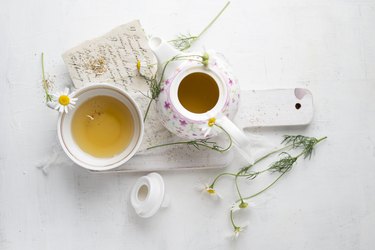
Chamomile tea is made from the Asteraceae plant family (the flower looks similar to a daisy) and comes from ancient Greece. Chamomile contains flavonoids, terpenoids, antioxidants and is caffeine free, according to The Cleveland Clinic.
Chamomile tea has been around since the time of the ancient Egyptians. The Romans and the Greeks loved to drink this tea and many generations have enjoyed its benefits across the world and throughout centuries. To get the very best out of your tea, go for dried chamomile made from whole chamomile flower heads.
Video of the Day
Video of the Day
Read More: 10 Everyday Ailments Soothed by Tea
Chamomile Tea Side Effects
Generally, chamomile tea is considered safe. The side effects are rare and usually occur for people who already have an allergy to chamomile tea itself. When such people drink tea with high concentrations of chamomile, they may experience nausea and vomiting.
If you have any allergies to plants of the daisy and aster family, then you may also be allergic to chamomile tea, as it is in the same family. The same applies if you have allergies to pollen, such as when you have hay fever. The best thing to do if you suspect you might be allergic to chamomile tea is to consult your health professional or allergy and immunology doctor for advice.
Additionally, chamomile tea is a naturally occurring blood thinner. If you're taking blood thinner medications, you will need to avoid chamomile tea.
Benefits of Chamomile Tea
Chamomile tea has long been known as an excellent aid to digestion. The National Center for Complementary and Integrative Health (NCCIH) notes the numerous benefits of chamomile tea. For digestive relief, consider drinking chamomile tea for diarrhea, ulcers, colic acid, indigestion, gastritis and irritable bowel syndrome.
Chamomile tea is also quite helpful for alleviating stress and releasing tension headaches. It also helps with menstrual cramps, and can even offer anti-fungal, antiviral and antibacterial properties.
Chamomile is quite often used in Europe and other parts of the world as a soothing cream for irritated skin. It is applied topically and is known to make the skin softer. It may also reduce inflammation on the skin and is known to eliminate rashes on the skin and provide relief from sunburns. Some preliminary research noted from NCCIH shows that chamomile might be effective as a treatment against eczema, a rather stubborn skin disease.
Chamomile is also sometimes applied on the inside of the mouth to relieve irritations in the mouth and gums. However, the studies on just how effective it is in this capacity are inconclusive. Still, chamomile has been found to be effective in the mouth in other ways. A March 2016 study published in Integrative Cancer Therapies shows that it can be used as a preventative measure to stop mouth sores caused by chemotherapy and radiation from forming.
When applying chamomile tea to your skin, be sure to make a compress first. You can do this by soaking a piece of cloth in warm hot chamomile tea or adding chamomile tea to a warm bath.
Read More: The Best Drinks When You Are Feeling Sick
Chamomile Tea and Sleep
Chamomile tea is known to relax muscles and give strength to the immune system, according to NCCIH. It's been shown to be effective as a sedative, which is why chamomile tea is often recommended for help with sleep. It also helps with the ability to fight common cold symptoms.
Drinking the tea increases levels of hippurate in the body. Hippurate is a by-product of phenolics, which are plant-based compounds that increase the body's antibacterial activity. That is one possible explanation for why chamomile tea leads to a boost in the immune system.
Read More: All Natural Teas That Flatten the Stomach